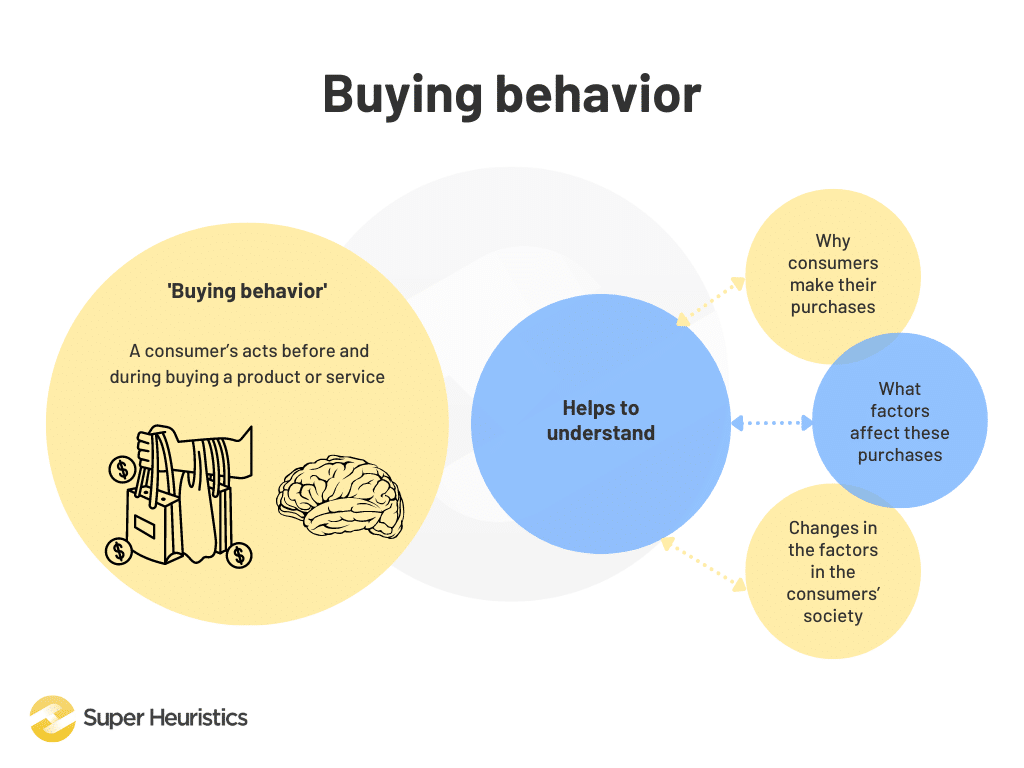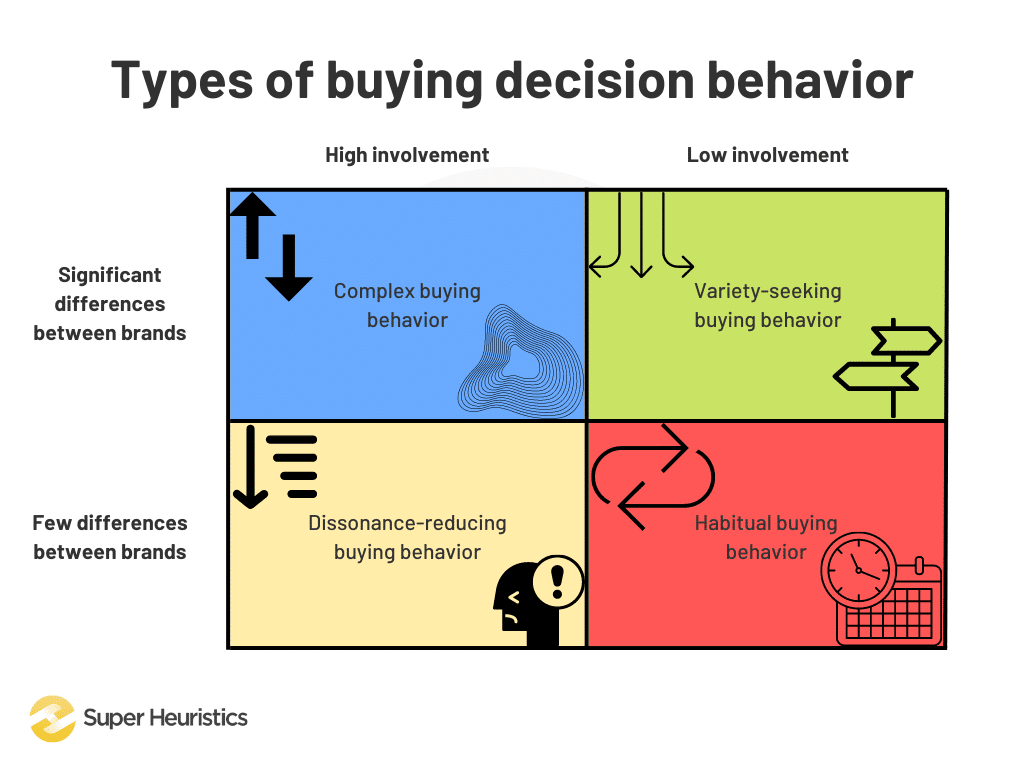Till now, we have studied the different types of factors affecting consumer behavior. For each individual, all these factors will play an important role in differently affecting their consumer behavior. In turn, all these individuals will have different types of buying decision behaviors.
In essence, there will be a different environment for each consumer to make their buying decision in, even for the same product. This means we will have to consider the different types of buying decision behaviors in which we can classify different consumers.
Let us take the instant noodles example we started our journey in consumer behavior with in Chapter 1. Imagine that you are part of a friend group with three other people. All of you go to the same supermarket near your campus to buy instant noodles.
The first person always buys the most expensive and weird brand of instant noodles on the rack. They have never tried the product before, but they always have an explanation for why they bought the fiery cheesy seafood flavor of a Korean instant noodles brand, for example.
The second person in the group is highly gullible. They always complain about the instant noodles they bought the previous time and want to buy the instant noodles whose advertisement they saw most recently.
Let’s consider you as the third person in the group. You are the one who plays it safe and always saves the group by keeping a stack of the instant noodles everyone likes. You are loyal to your favorite brand of instant noodles and don’t pay much attention to other brands.
The fourth and last person in your group is the one who always sees the variety of instant noodles on the rack and instantly thinks that they want them all. They wish to try each and every brand without any solid background information and don’t mind spending the extra bucks.
You must have noticed that even though all four of you are the same age, live on the same campus, and have more or less the same circumstances, there are significant differences in how and why you buy the same product.
Through this example, I have broadly informed you about the four types of buying behavior. We study these types of buying decision behavior to understand which type of consumers a company would want to market to and why.
Before we can move on to its types, we need to understand what buying decision behavior is all about. Let’s get started.
Understanding what ‘buying decision behavior’ is
You might recall from the first chapter in this series that we defined ‘buying behavior’ as ‘a consumer’s acts before and during buying a product or service.’
This same term is sometimes called consumer buying behavior or buying decision behavior. It is basically the decision processes and acts of people involved in buying and using products and services.
Marketers study buying decision behavior to understand:
- Why consumers make their purchases
- What factors affect these purchases
- Changes in the factors in the consumers’ society

It is important for marketers to analyze decision behavior for multiple reasons, including
- Buyers’ reactions to the firm’s marketing strategy determine the firm’s success.
- Determining the marketing mix (product, price, place, promotion) to satisfy consumer needs requires the marketer to analyze what consumers buy, from where, when, and how.
- Analysis is needed to better predict how consumers might respond to the firm’s marketing strategies.
Now that we understand what buying decision behavior is, let us move on to the actual subject of this Chapter - the types of buying decision behavior.
Understanding the types of buying decision behavior
We understood from the example of your friend group, that we can classify consumers into four types based on how they make their purchases of the same product. These four types of consumers are classified on the basis of their buying behavior.
Let us take these four types of buying decision behaviors one by one, this time with their proper names.

High involvement implies that the consumer is more invested in the buying process, while low involvement implies that the consumer is not very invested in the buying process. For example, some consumers like to perform due diligence on their own before making a purchase, whereas others just go with the flow.
In other words, high involvement implies that a consumer actively looks for information that can enrich their buying process. High involvement behaviors are usually observed when the purchase is infrequent, the product is costly, the purchase might be risky overall, etc.
Low involvement implies that the consumer does not feel the need to actively look for information about the purchase because it does not involve a lot of risks. For example, when buying shampoos or detergents, a consumer is likely to just go and buy a famous brand or one they have been buying since a long time instead of researching the pros and cons of each competing brand in the market.
1. Complex buying behavior
According to Philip Kotler, complex buying behavior ‘occurs when consumers are highly motivated in a purchase and perceive significant differences among brands.’
He says that consumers under this category are highly motivated when:
The product is expensive.
The product is risky.
The product is purchased infrequently.
The product is highly self-expressive.
However, this type of behavior is observed only when there are significant differences between brands. The purchases under this category demand long-term commitment from the buyer and are costly and risky.
For example, let’s imagine that you want to buy a house after saving up just enough to buy one. You are employed in your first job and are now so financially secure that you can afford to buy a house without becoming completely dependent on someone else.
You realize that this is a big commitment, both financially and emotionally. You might end up starting a family in that house, making it home not only for yourself but also for your partner and children.
Instead of buying the first house you visit, you will probably visit many realtors’ websites and take virtual tours of houses. There are too many differences in each house you start to like as compared to the last. You gather as much information as you can about each and every house within your budget.
It is a high-risk decision that requires huge financial investment. You probably won’t buy a house again for at least 5-10 years, so it is an infrequent purchase. Moreover, the house you buy will be associated with you for a long time, so it is also a means of self-expression.
Since you gathered a lot of information before finally purchasing the best-fit house, you are engaged in complex buying behavior. This does not mean that you will always have complex buying behavior in every purchase but that you engaged in complex buying behavior in this particular instance.
Some other examples where consumers use complex buying behavior are automobiles, computers, etc.
Marketers for such products should readily provide as much information as possible about their offerings. This should also include the benefits of buying their products, as it will help in influencing the consumers’ purchase decisions.
2. Dissonance-reducing buying behavior
According to Kotler, ‘dissonance-reducing buying behavior’ occurs when consumers are highly involved with an expensive, infrequent, or risky purchase but see little difference among brands.
Although consumers are highly involved when they engage in dissonance-reducing buying behavior, they see little difference between the various brands available to them. This is also observed only in infrequent purchases where choices available to the consumer are limited.
For example, imagine that you go to a jewelry store to look for a diamond ring to propose to your partner. This is also a huge financial investment and definitely a risky one. Maybe your partner will say no to you! They might not be ready to get married and settle down just yet.
However, your budget is limited, and so are your options. After visiting a few jewelry stores, you realize that there are not many alternatives. All the rings look the same to you. Their prices are also not very different.
Finally, you buy a ring that is within your budget and has a beautifully-cut diamond sitting on an elegant platinum band. A week later, you propose to your partner at dinner, and you are ecstatic to hear their yes.
However, a few days later, a work friend shows you a diamond ring they bought for their partner. You ask them about the specifics and realize that they bought the ring at the same price from the only store you didn’t visit! You feel that the ring is much prettier than the one you bought and are slightly disappointed.
This phenomenon is known as post-purchase dissonance. It is common among consumers engaging in dissonance-reducing buying behavior.
Kotler defines post-purchase dissonance as something that occurs when the consumer notices certain disadvantages of the product purchased or hears favorable things about a product not purchased.
Consumers experiencing post-purchase dissonance tend to look for information that justifies their purchase. Marketers can use post-sales services to attract these consumers to repeat purchases. These consumers must be made aware that their wants are being conveyed to the brand and that the brand is working to make their experience more pleasant.
Dissonance-reducing buying behavior is also observed in certain instances and is not always engaged in by a single consumer. Other examples of products where dissonance-reducing buying behavior is observed include TVs, smartphones, refrigerators, etc.
3. Habitual buying behavior
According to Kotler, habitual buying behavior occurs when consumers have low involvement and there is little significant brand difference.
As the name suggests, these are products and services that the consumer buys out of habit. Since consumer has been using the same brand for a long time, they need not conduct any research about the options available to them.
Also, there aren’t any significant differences between the different brands available in the market. Consumers may not have a strong liking for the brand but buy it because they are familiar with it. So, they put familiarity over loyalty.
Marketers should use repetitive promotional campaigns so that the consumer can feel even more familiar with the brand. This may include using the same imagery in their campaigns. They may also try to make the product more involving through awareness campaigns, etc.
For example, when you go to the supermarket to buy toothpaste, you probably don’t look around to find something new. If you’ve been a Colgate consumer for some time, you feel that it’s familiar to you. It is a daily-use item, and switching to a new toothpaste may feel uncomfortable.
Other examples of situations where consumers use habitual buying behavior include milk, bread, and other grocery staples, hygiene products like shampoo and soap, etc. The instant noodles example we have been using in the previous chapters can also fit here. Again, this type of buying behavior is also observed in all consumers in some situations but not in a single consumer always.
4. Variety-seeking buying behavior
According to Kotler, variety-seeking buying behavior occurs when consumers have low involvement, and there are significant brand differences.
This type of buying behavior is observed when the cost of switching to a new brand is low. If the consumer gets bored with one brand, they can easily switch to another brand that is significantly different from the one they are used to. One reason why consumers might make a switch is to prevent losing utility from purchasing the same things or consuming them repeatedly.
While the dominant firms in a certain market will try to get the consumers to become loyal to the brand by encouraging habitual buying behavior, competitors might offer free samples, discounts, and innovative advertising to prospective consumers.
For example, imagine that you go to the supermarket to buy some chips. Let’s say that you bought Lay’s chips last time. But this time, you feel like having nachos. So, you may buy Cornitos or Doritos instead of Lay’s simply because you can. The cost of switching to this new brand is next to zero, even though there are significant differences between the two brands.
Other products where this behavior can be observed are soft drinks, cereals, packaged snacks, etc. If a single brand can satisfy the consumer’s needs accurately, there is a small chance that the consumer might go for a repeat purchase.
This type of buying behavior is also observed in certain situations only. No consumer always has variety-seeking buying behavior in all purchases.
It is clear that consumers can be classified according to the types of buying decision behavior that they generally have, but a single consumer does not need to have a linear buying decision behavior. In fact, some believe that there are more than four types of buying behaviors. Head to this link to read about Indeed's 11 types of buying behaviors.
Conclusion and key takeaways
In this chapter, we have studied the types of buying decision behavior. To recall, let’s take a look at some key takeaways:
- Buying behavior is a consumer’s acts before and during buying a product or service.
- The buying decision process is defined as ‘the decision-making process used by consumers regarding the market transactions before, during, and after the purchase of a good or service.’
- According to Philip Kotler, complex buying behavior ‘occurs when consumers are highly motivated in a purchase and perceive significant differences among brands.’ Consumers under this category are highly motivated when the product is expensive, risky, purchased infrequently, and/or highly self-expressive.
- According to Kotler, ‘dissonance-reducing buying behavior’ occurs when consumers are highly involved with an expensive, infrequent, or risky purchase but see little difference among brands. Kotler defines post-purchase dissonance as something that occurs when the consumer notices certain disadvantages of the product purchased or hears favorable things about a product not purchased.
- According to Kotler, habitual buying behavior occurs when consumers have low involvement, and there is little significant brand difference.
- According to Kotler, variety-seeking buying behavior occurs when consumers have low involvement, and there are significant brand differences.
In the next chapter, we will study the buyer decision process.

